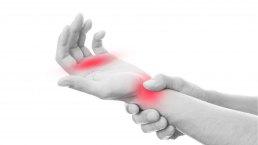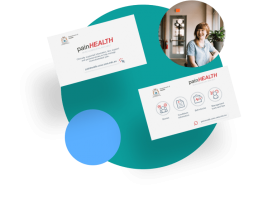Complex Regional Pain Syndrome
Learn about Complex Regional Pain Syndrome (CRPS) and what you can do to help recovery.
Last updated: 28 Oct 2023 · 4 min read
Complex regional pain syndrome (CRPS) is a syndrome that can occur after simple injuries such as a sprained ankle or a broken arm. While CRPS only affects a small proportion of people, it can be very painful and disabling. There are 2 main types of CRPS:
- Type I can occur after a simple injury such as a sprain or broken bone (hand or foot etc), after a stroke or without a known cause1.
- Type II can occur after injury or damage to a nerve in the arm or leg or after surgery to repair an injured nerve, for example, carpal tunnel syndrome.
What are the symptoms of CRPS?
It can be difficult to make a firm diagnosis of CRPS early in the course of this condition. There are a number of features that may suggest you have CRPS I or II. These include:
- severe pain, often out of proportion to the initial injury
- increased skin sensitivity
- swelling
- excessive sweating or dryness of the skin
- skin feeling warm or cold
- skin colour red or blue
- either extra or less hair growth in the area
- brittle finger nails
- muscle spasm, muscle contractures and difficulty coordinating and moving.
These features can spread, so that the pain takes on a glove-like (hand/arm) or sock-like (foot/leg) pattern of spread.
It is common to have some symptoms like this after limb fractures (breaks) or surgery. The good news is that in most cases the pain improves substantially on its own. It is rare for CRPS-like symptoms to last longer than a few months but in a minority of cases, pain and disability can persist1.
Have you got CRPS?
If you think you may have CRPS, it’s a good idea to seek help from your health professional.
You can also complete our CRPS self-check to help screen for CRPS. This questionnaire is based on current best evidence research, however, it is not perfect. It is not intended to replace a face-to-face interview with your health professional.
If you are experiencing significant physical or emotional difficulties, contact your GP for a referral to a qualified health care professional.
What treatments are best for managing CRPS?
As a first step, have a clinical consultation.
Currently, there are not enough high quality studies to guide clear treatment decisions in CRPS. Clinical guidelines, which represent the available evidence and the views of clinical experts in CRPS (for example1) suggest a number of treatments that may be helpful.
All clinical guidelines recommend rehabilitation therapy as the first line of treatment. This might be guided by a physiotherapist, an occupational therapist or a specialist nurse. Rehabilitation therapy usually involves things like education on how to best manage your symptoms, graded exercises and techniques to try to make the limb less sensitive. There is some evidence to show these things may help3 although they cannot yet be said to be “proven”2. Therapies include:
- helping you to better understand your symptoms
- giving you an exercise program to help get your limb moving and to help you use your limb more normally
- using techniques to reduce the sensitivity of your limb
- teaching you strategies to help cope with and manage your symptoms.
As well as rehabilitation therapy, there are some drugs that may help. We do not know exactly which medicines are best for helping the pain of CRPS though your doctor may recommend medicines that are commonly used for other types of severe or persistent pain (see our module on Medicine and procedures). With any medicine therapy, your progress should be reviewed regularly by your doctor. If the medicine is not helping you, or is causing you problems, you can consider trying a different treatment.
Your GP may also discuss the option of referring you to a specialist doctor, for example, a Pain Specialist or a Rheumatologist. These specialists can offer additional treatments. This may involve more specialist rehabilitation therapy or trials of different medicines. For example, as well as the medicines that are commonly used for pain relief, there is some evidence2 that medicines known as bisphosphonates may be helpful in CRPS. These drugs are generally used for other conditions, particularly osteoporosis, but they may help some people with CRPS3. They are normally prescribed for CRPS by a Pain Specialist.
Over the years, a lot of different treatments have been used for CRPS such as “invasive” medical procedures including nerve blocks, delivery of medicines intravenously, and surgical approaches. Some of these have been shown not to work (for example, intravenous nerve blocks with guanethidine2) and they shouldn’t be offered, but for most of these treatments, it is simply not yet known if they are helpful2,4.
For severe and persistent cases of CRPS, there is some evidence that spinal cord stimulation, (in which small electrodes are surgically implanted in the nerves around the spine and the nerves are then stimulated with electrical current), may help improve pain. For some people, this may make it easier to use the affected limb3. You can find more information by reading our medicines and procedures training module.
So, to summarise – if you think you may have CRPS, here are 4 steps to take:
- See your GP to discuss your symptoms and concerns
- If CRPS is the problem, seek a referral to a rehabilitation therapist, preferably with CRPS experience
- Talk to your Doctor about the pros and cons of possible medicines for pain relief
- If things are not improving, talk to your health professional about a referral to a specialist service.
Download our postcard
We've just created a postcard PDF you can download to share with your patients easily.
Choosing care for CRPS
It is important to choose treatment options that are most likely to give you the most benefit with the least risk and cost. See our CRPS value-based care fact sheet. While the evidence for what helps for CRPS is limited, clinical guidelines suggest:
- The first line step is to see a rehabilitation specialist. This is usually either a physiotherapist, an occupational therapist or a specialist nurse.
- Seek advice about the drugs and invasive procedures that may help some people with CRPS, but be aware that the evidence for these is limited.
Some treatments that may still be offered to people with CRPS can be considered to be low value, which means they provide little benefit. In some cases, they may even cause harm.
Examples of these include:
- Intravenous regional nerve blocks with drugs such as guanethidine2
- Local sympathetic nerve blocks4.
For these treatments, there is either evidence that they don’t work, or a lack of trustworthy evidence that they do work.
When talking to your doctor or healthcare provider about possible tests or treatments for your care, there are 5 key questions to ask:
- Do I really need this test or procedure?
- What are the risks of this test or procedure?
- Are there simpler, safer options for me?
- What happens if I don’t do anything?
- What are the costs?
Use these 5 questions to make sure you end up with the right amount of care — not too much and not too little. To find out more, visit the Choosing Wisely initiative.
Further information
If you’re seeking further information about Complex Regional Pain Syndrome, we recommend you visit Cochrane Summaries and contact your local health professional for further assistance to better manage your pain.
Pacing and goal settings
Approaching Pain
About pain
Complex Regional Pain Syndrome: Promoting wise healthcare
Choosing Wisely
- Royal College of Physicians. Complex regional pain syndrome in adults. UK guidelines for diagnosis referral and management in primary and secondary care. 2nd edition 2018 [Link];
- O’Connell NE, Wand BM, McAuley J, Marston L, Moseley GL. Interventions for treating pain and disability in adults with complex regional pain syndrome. The Cochrane database of systematic reviews. 2013(4):CD009416. [PubMed]
- Smart KM, Wand BM, O’Connell NE. Physiotherapy for pain and disability in adults with complex regional pain syndrome (CRPS) types I and II. The Cochrane database of systematic reviews. 2016;2:CD010853. [PubMed]
- O’Connell NE, Wand BM, Gibson W, Carr DB, Birklein F, Stanton TR. Local anaesthetic sympathetic blockade for complex regional pain syndrome. Cochrane Database of Systematic Reviews. 2016;7:CD004598 [PubMed]
This module has been developed by Neil O’Connell PhD; MSc, Senior Lecturer, Department of Clinical Sciences, College of Health and Life Sciences, Brunel University London, UK; and Helen Slater, PhD; FACP; MAppSc(Phty), BAppSc(Phty), Professor, School of Physiotherapy and Exercise Science, Curtin University, Perth, Australia.
The information in this module is based on current best evidence research and clinical practice.
SHARE THIS ARTICLE
Pain management information, stories and tips accessible anywhere, anytime.
Access clinically supported practical musculoskeletal pain management information to help you understand pain, how you can manage your pain with your management team on the go on any device.

